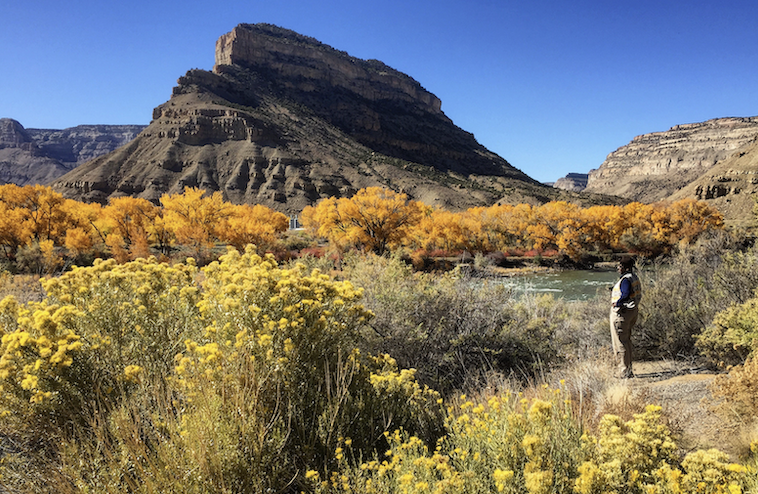
A roadside stop on I-70 near Rifle on the way to Grand Junction is a sea of cottonwoods, the equally colorful cousin of aspens. Photo by Rich Grant
By Rich Grant
It’s not difficult to see fall colors in Colorado. There are more than two million acres of aspen trees in the state — one billion trees that, if placed together, would cover Rhode Island and Delaware.
And what a show they put on! Rocky Mountain aspen leaves don’t just change color in the fall; they positively glow a luminescent yellow gold, almost as if they had their own light source. The leaves are small, delicate, and tissue-thin with an aerodynamic shape that keeps them in perpetual motion. Even a slight breeze sends every leaf on the tree shimmering. Set against a deep Colorado blue sky, it is one of the world’s most beautiful sights.
And because aspen trees (and their equally colorful cousins, the cottonwoods) turn color based in part on elevation, fall colors in Colorado last from mid-September through Thanksgiving. Generally, the higher the elevation, the sooner the leaves turn gold with the highest starting mid-September. That means that over a period, you can often see a variety of shades of color on one mountainside, with deeper golds on top at 10,000 feet, blending to pale yellow in the 8,000-foot range. And then in later October, all the hardwood trees down in Denver go through their fireworks of color through Halloween and on.
So, it’s not hard to see fall colors in Colorado, but best of all, is the many different ways that you can view them! Here are eight fun suggestions.
VIEW ASPENS WHILE RIDING A STEAM TRAIN
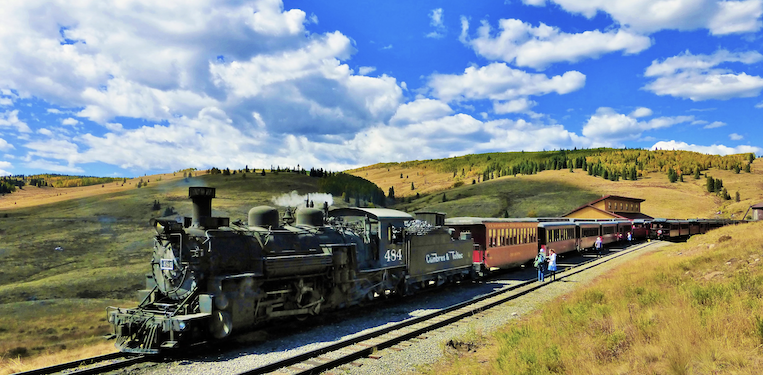
The Cumbres & Toltec Scenic Railroad stops for an hour off-train lunch of regional specialties at scenic Osier Station, surrounded by aspen trees.
Could there be a more romantic way to enjoy fall colors in Colorado than riding at 12 mph through groves of golden aspens pulled by a steam locomotive, the whistle echoing off the hills, smoke billowing into the sky as you curl along 600-foot high cliffs, cross raging rivers on trestles, chug through tunnels, view wildlife and wildflowers, and travel for 64 miles off-the-grid where no cars can go? Absolutely not! All of Colorado’s narrow gauge steam railroads travel through aspen groves, but my favorite is The Cumbres & Toltec Scenic Railroad.
Built in 1880, this is America’s highest and longest steam railroad, crossing Cumbres Pass at 10,015 feet elevation as it steams for 64 miles from the little town of Antonito CO to the small riverside village of Chama NM, crossing state borders 11 times, much of it through forests of glowing aspens or along riverbanks lined with golden cottonwoods. Passengers can ride in coach or in luxurious cars that simulate the opulent wealth of railroad barons. You can also ride between cars to get a special photograph as you travel through aspen groves or in an outdoor gondola car where you can hear every bell and whistle as you enjoy spectacular mountain views, so close to the tree branches you can practically reach out and touch them. But of course, that would be a terrible idea if you want to keep your hand, even at just 12 miles an hour.
The non-profit railroad is owned by the states of Colorado and New Mexico. All full-day rides include a hot lunch of regional cuisine at beautiful Osier Station. The last train operates on October 25, 2025. Reservations are necessary.
VIEW SPECTACULAR VALLEYS OF ASPENS FROM A FREE GONDOLA RIDE
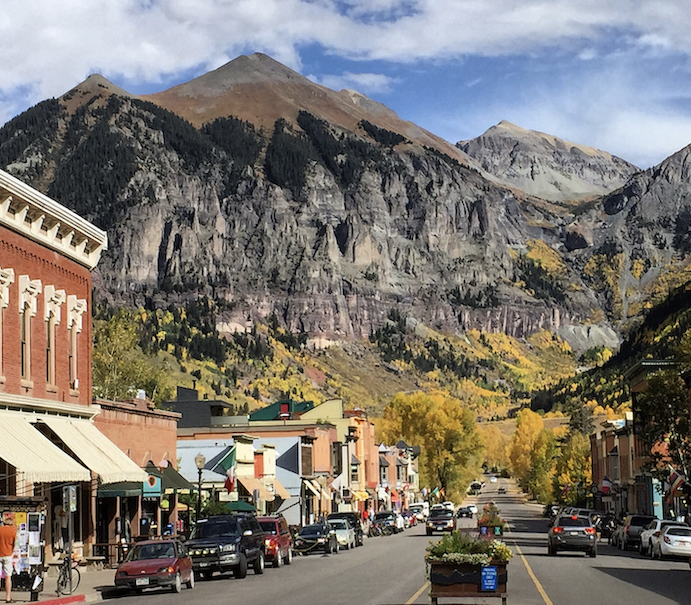
The historic town of Telluride is connected to a modern resort up higher by a series of free gondolas, all sailing above a forest of aspens. Photo by Rich Grant
Telluride is not the easiest place in the world to get to, which is why Oprah, Ralph Lauren and Jerry Seinfeld have houses there. Butch Cassidy robbed his first bank in Telluride. But truth be told, most people who have been everywhere in Colorado (including me) will concede that this is the prettiest place in the state. Especially in the fall. The narrow, steep valley leading to Telluride is ablaze with fall colors. The road ends here (unless you have a jeep and a lot of nerve), and there is an “end-of-the-world” feeling about this town, as if you have arrived and there’s no better place left to go.
Most unusual for Colorado, the gondolas traveling from the historic town at the bottom of the valley to the modern resort up higher in the mountains …. are free! Yes, you can ride the gondolas endlessly for free over a sea of gold. It’s the only free gondola system of its kind in the nation.
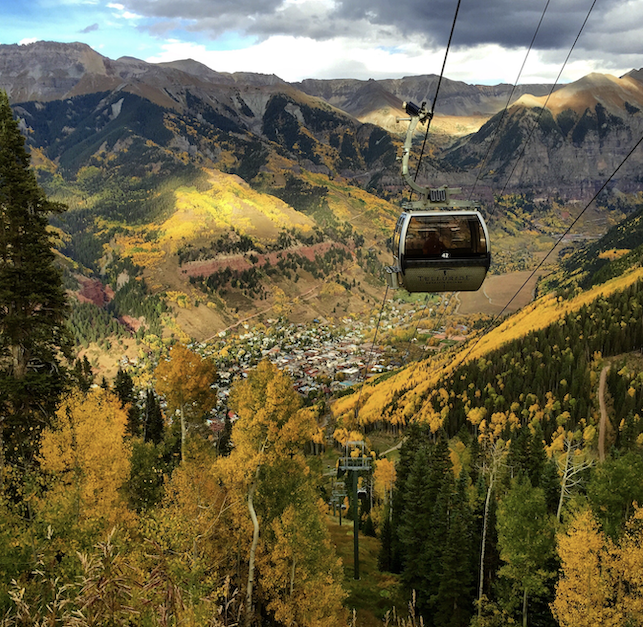
The gondolas in Telluride are free and make an excellent way to see fall colors. Photo by Rich Grant
ELECTRIC BIKE YOUR WAY FROM ONE GOLD RUSH TOWN TO ANOTHER
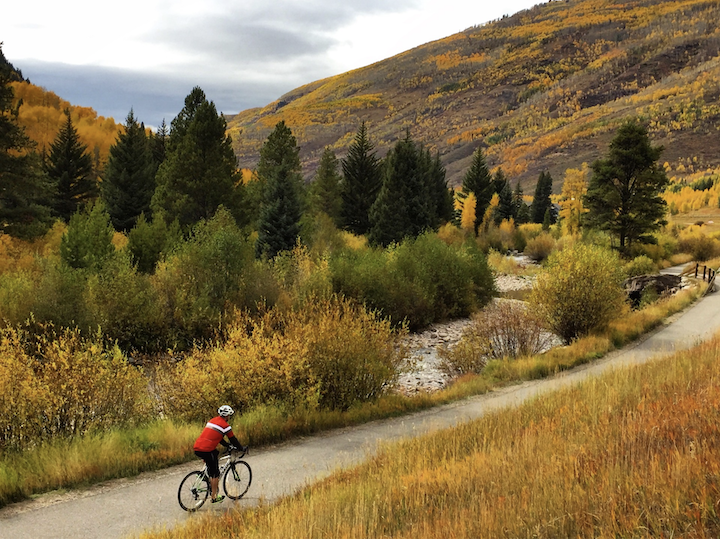
Paved bike trails run through forests of aspens from Lake Dillon over Vail Pass and then on to Vail. Photo by Rich Grant
For better or worse, electric bikes have changed the way people cycle in Colorado and have opened new possibilities for older visitors who find cycling at two miles above sea level difficult. Summit County, just 90 minutes on a good day from Denver, is an outdoor playground of five towns circling or near one of Colorado’s largest and most scenic lakes – Dillon Reservoir. The original gold mining town of Dillon is buried under the lake, but a new town has grown up on the hills surrounding the reservoir. It is now known for its marina and the paved biking trails that connect it to Silverthorne, Frisco, Keystone, and Breckenridge. Silverthorne is the shopping capital of the Rockies with a massive factory outlet center along the Blue River. Bridges and bike paths connect famous name-brand stores. Frisco, on the other hand, was founded in 1870 and once had two railroads, a slew of saloons, shops, and hotels. But the depression hit Frisco hard. By 1930, there were only 18 people left in town. Frisco didn’t even get indoor plumbing until 1950! But in the 1960s, Colorado’s ski industry was born with Vail, Breckenridge, Keystone, and Copper Mountain all just a short drive away. The former Ghost Town of Frisco boomed again with white gold.
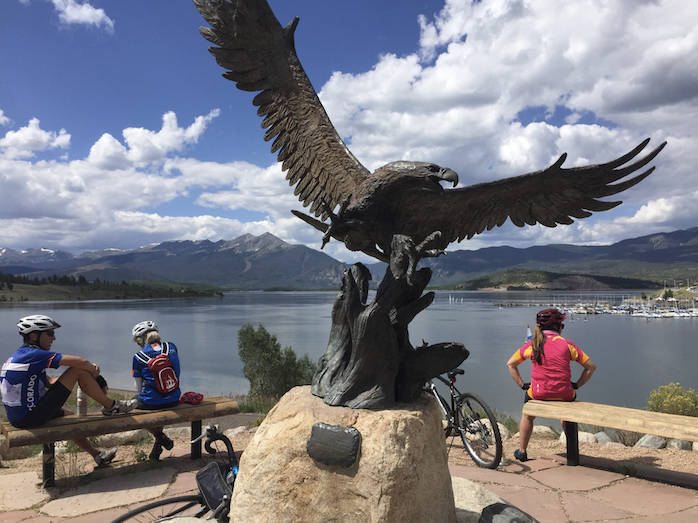
Pausing to rest along the bike trail circling Lake Dillon. Photo by Rich Grant
Today, there are 2,800 full-time residents and 34 bars and restaurants. The Frisco Historic Park has relocated a dozen buildings, including an old jail, schoolhouse, ranch house, trapper’s cabin, chapel, and others, and built them into a beautiful park on Main Street surrounded by aspen trees. The major resorts of Keystone and Breckenridge are nearby, and the entire county is awash with aspens and fall colors. There’s a free bus service that connects all these towns. You may also rent an electric bike (available everywhere). It is a relatively easy to pedal from outdoor café to outdoor café along the Snake River from Keystone village, down and around the reservoir to Frisco, and up over a slight hill to Breckenridge and put your bike on a free shuttle bus back to your hotel. If you have a friend to drive you, you can even go to the top of Vail Pass and bike down to Copper Mountain ski resort and on to Frisco. The routes are endless, almost always beside a river or lake, and filled with aspens.
HIKE TO ASPENS
Colorado has 43 state parks, 13 national parks and monuments, 13 national forests and grasslands, and 58 Fourteeners (peaks that rise more than 14,000 feet above sea level). All of these are crossed by more than 39,000 miles of Colorado hiking trails, all well documented by the state in a site which can be accessed here. So, where to go? Did we mention there are 39,000 miles of trails? The good news is you can go practically anywhere and have a wonderful hike. The bad news is that the usual suspects like Rocky Mountain National Park may be incredibly crowded. At the risk of being ostracized by my friends, the best, easiest aspen hike is the Abyss Lake Trail off of Guanella Pass. Because it is close to Denver, Guanella Pass is a great “leaf peeper” road that gets crowded with cars on weekends, but not that many people stop and hike. The Abyss Lake Trailhead is mostly known for the grueling 16-mile round-trip hike to the lake. However, the first two relatively flat miles take you to a valley surrounded by a mountainside of aspens beside a beautiful river. You can turn around here and drop down the pass to the beautiful village of Georgetown for a beer in a historic saloon.
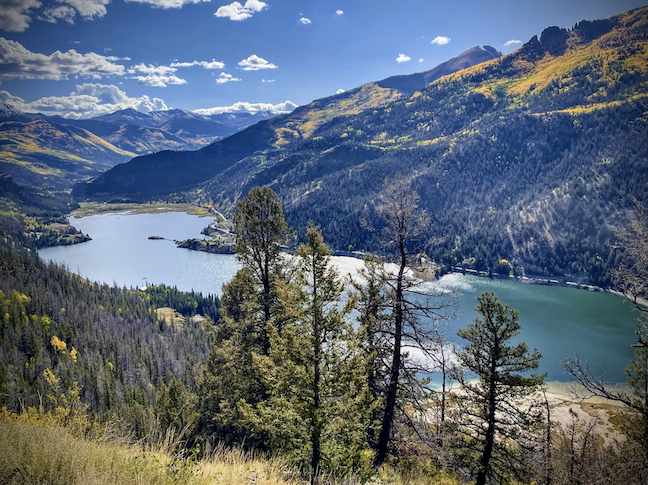
Lake San Cristobal on the Silver Thread Scenic Byway. Photo by Rich Grant
DRIVE AN INTERSTATE TO VIEW ASPENS AND COTTONWOODS
“Leaf Peepers” are a bane to the young, healthy, athletic population of Colorado, which at times can seem like everyone. But not everyone is young and healthy, and there are dozens of ways to enjoy fall colors on a “Sunday drive.” Only don’t do it on Sunday! Every other day of the week is better and less crowded. The great fall color drive of Colorado is ironically a four-lane interstate, I-70, which crosses the state. You’ll see incredible fall colors in Georgetown and Silver Plume (there’s even a steam train here to ride). You’ll climb through the Eisenhower Tunnel at 11,000 feet, the highest auto tunnel in the world outside of China, before zipping through Summit County, where others are probably biking. Drive slowly along the main street of Vail and stop for photos along Beaver Creek before cruising through rocky Glenwood Canyon. Beyond the canyon is the Colorado River, which sluices through a forest of yellow and gold cottonwoods to the Red Rock country of Colorado National Monument in the city of Grand Junction.
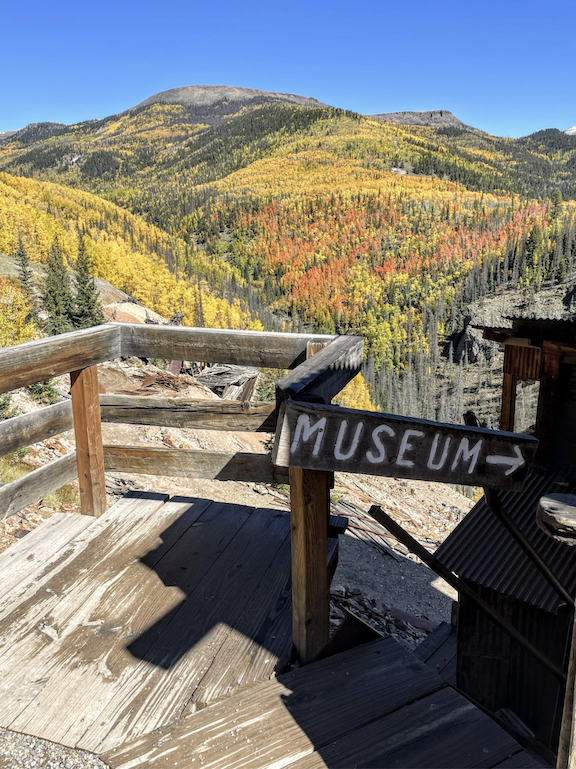
Bachelor Gulch has a couple of mining museums. Photo by Rich Grant
Cottonwoods don’t get the same respect as aspens, but they are just as colorful. They often are found along riverbanks in front of huge cliffs of red sandstone. There are not many trees in Colorado National Monument, but as you drive this incredible treasure you can look down on a green valley dotted with beautiful fall color following the Colorado River. This is also wine country with dozens of vineyards in the town of Palisade, making wine tasting another great fall activity.
TAKE A SCENIC BYWAY TO ASPENS
Colorado has 26 Scenic Byways that will take you to aspens and off-the-beaten-path adventures. In autumn, you want to be on the Silver Thread linking South Fork to Creede and Lake City. Forget your cell phone, it may not work as you follow an off-the-grid path along the Rio Grande River to its headwaters. Yes, the same Rio Grande that separates the U.S. and Mexico.
A highlight comes in Creede, a one-time wild coal mining town once controlled by the “dirty little coward” Bob Ford, who shot Jesse James in the back, only later to be gunned down in cold blood in Creede himself. His lonely grave is above the town.
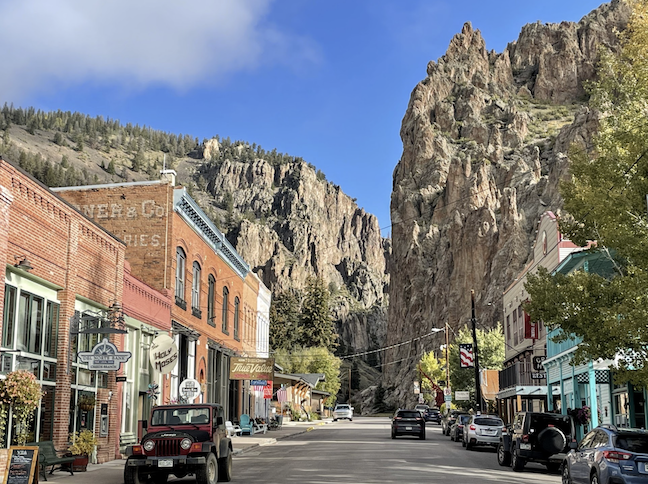
Downtown Creede on the Silver Thread Scenic Byway. Photo by Rich Grant
Creede is a wonderful place of shops, restaurants, breweries, and even a repertory theater, all in a setting surrounded by cliffs. Those with a four-wheel drive vehicle and a little nerve can enter those cliffs and follow the 17-mile Bachelor Loop past picture-book mining operations and over steep grades surrounded by aspen groves. The paved scenic byway continues over Slumgullion Pass, the steepest grade of any continuously paved road in Colorado, to scenic Lake City and beautiful Lake San Cristobal.
Lake City is where Alfred Packer was tried as a cannibal in 1883 for killing, and possibly eating, some of a snowbound party heading west. The judge, by local newspaper accounts, said, “Alfred Packer, when yah came to Hinsdale County, there was siven Dimmycrats. But you, yah et five of ’em, goddam yah. I sintince yah t’ be hanged by th’ neck ontil yer dead, dead, dead.”
Well, maybe. Legal technicalities kept Alfred Packer alive, and thanks to fun-loving students, the cafeteria at the University of Colorado is now named after him.
RELAX UNDER ASPENS AND COTTONWOODS ON AN EASY, RIVERSIDE STROL
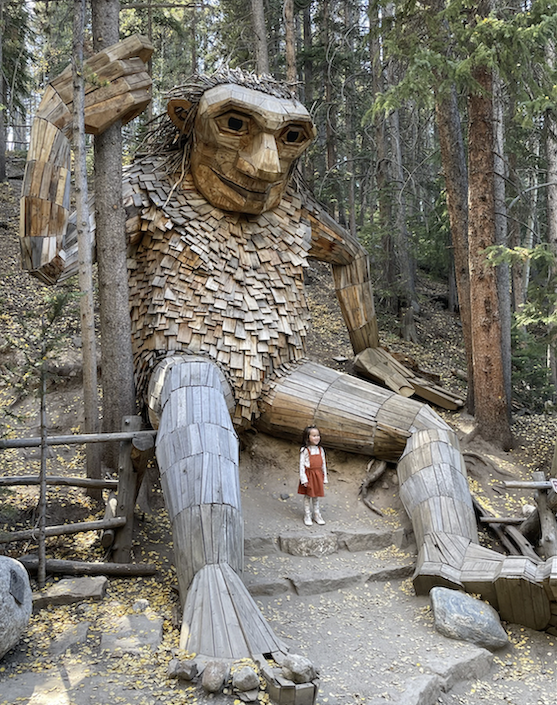
Breckenridge’s Troll, just off the bike trail. Photo by Rich Grant
If just walking and strolling is more to your taste, then stay down on the plains. It’s a Denver tradition that the first snow falls on Halloween, and more often than not, that’s true. Until then, Denver, 5,000 feet lower than Breckenridge, is a fireworks show of fall colors, most of which linger into November. Unlike the rest of Colorado, Denver, at only 5,280 ft., has become a botanist’s dream. Abundant sunshine and plenty of water from the mountains allow Denver to experiment with every type of tree. Maples, oaks, ash, linden, and locust have all been planted in Denver. Indian summer leads to exceptionally warm days and cool evenings. Washington Park in Denver alone has more than 70 different types of trees.
Still craving some bright cottonwoods and creeks? The appropriately named town of Golden is just 12 miles away and is located where the mountains meet the plains. Golden offers one of the most delightful four-mile walks in Colorado along the banks of Clear Creek under a canopy of cottonwoods. There are restaurants along the riverbanks and craft breweries nearby. You’ll always find fall colors in Golden and Denver right up until Thanksgiving.
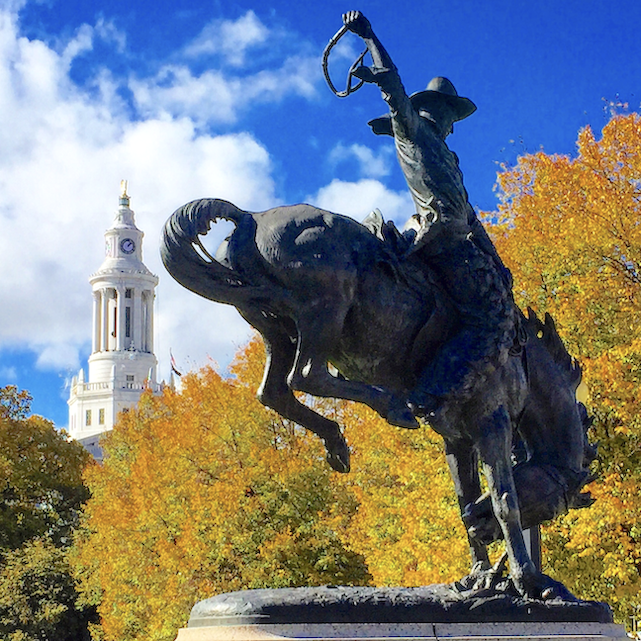
Denver is home to almost every variety of hardwood tree, which put on a show up to Halloween and beyond, such as here in Civic Center Park. Photo by Rich Grant
SEE THE MOST ICONIC, FAMOUS, AND SPECTACULAR FALL COLOR SHOW IN COLORADO – FROM A PARKING LOT
The international ski resort town of Aspen is so named because colorful trees surround it. It is certainly one of the premier spots for fall colors in Colorado. But the ultimate aspen “leaf peeping” experience on the planet is nearby at the Maroon Bells.
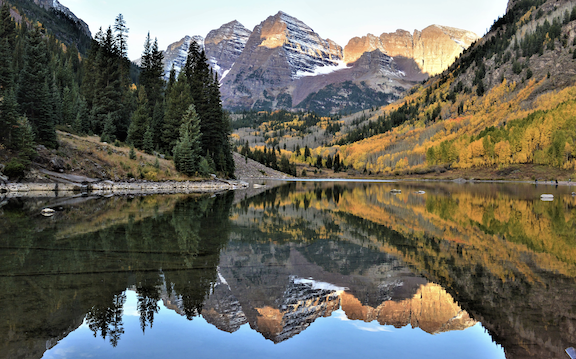
The Maroon Bells in Aspen, Colorado,can be seen from a parking lot just off the highway. Parking is in short supply during the fall foliage season, but it’s a view worth fighting for. Photo by Rich Grant
If you are one of the lucky few travelers to have already seen it at dawn, it’s easy to act superior and say, “Oh, skip it because of the crowds and the difficulty of getting there, and there are dozens of other places just as good.” There aren’t! This group of pyramid-shaped mountains at dawn during fall colors is as memorable as seeing the real pyramids in Egypt. Some 320,000 people visited last year. You can drive and park close to the lake in front of the peaks, just a stone’s throw from the parking lot. Ah, but getting in that parking lot? There lies the challenge. This link tells you all. Is it worth it? Yes. If you don’t get a reservation, are there equally beautiful spots to go? Yes. Thousands! But it’s worth a try, and don’t be disappointed if you don’t get in. You can always see aspens on a bike, hike, train ride, stroll, car drive on an Interstate or scenic byway, and even from a gondola.![]()
Rich Grant lives in Denver where he provides care for abused horses when not traveling. Please accompany him on a trip to Deadwood, South Dakota. It’s very different from Colorado.

